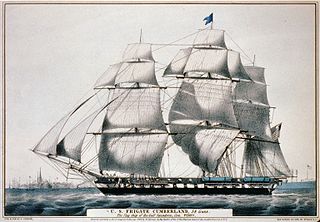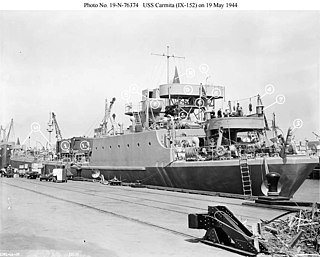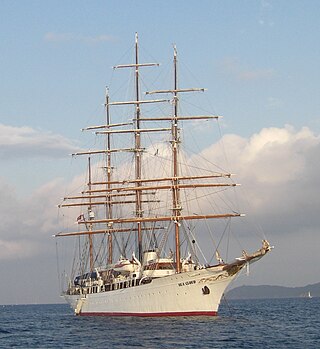
The first USS Cumberland was a 50-gun sailing frigate of the United States Navy. She was the first ship sunk by the ironclad CSS Virginia.

Stephen Decatur Sr. was an American privateer in the Revolutionary War and later in the Quasi-War was commissioned as a captain in the United States Navy. He was the father of Stephen Decatur Jr.

USS Helena (PG-9) was a Wilmington-class gunboat of the United States Navy. She participated in the Spanish–American War, and served in the Far East for many years. The (PG-9) was the first of five Navy vessels named after the capital city of Montana.

The USS Guinevere (IX-67) was a patrol vessel of the United States Navy that operated in service from 1942 to 1945.
Freedom (IX-43), an unclassified miscellaneous vessel, was the second ship of the United States Navy of that name. An auxiliary schooner, she was acquired by the Navy in 1940, and assigned to the United States Naval Academy where she served in a noncommissioned status through 1962.
USS Canandaigua (IX-233), an unclassified miscellaneous vessel, was the third ship of the United States Navy to be named for Canandaigua, New York.

USS Echo (IX-95), an unclassified miscellaneous vessel, was the only ship of the United States Navy to be named for the nymph Echo. A sailing scow, she was used as a supply ship in the South Pacific from 1942 to 1944.
USS Ramona (IX-76), an unclassified miscellaneous vessel, was the only ship of the United States Navy to be named for a title character in a novel. A steel-hulled schooner, her keel was laid down in 1920 by the Herreshoff Manufacturing Company, in Newport, Rhode Island. She was acquired by the Navy under bareboat charter from S. M. Spalding of Los Angeles, California, on 15 July 1942 and was placed in service 5 August 1942.
USS Gloria Dalton (IX-70), an unclassified miscellaneous vessel, was the only ship of the United States Navy to be given that name. Her keel was laid down in 1925 by Craig Shipbuilding Company, in Long Beach, California. She was purchased by the Navy 11 May 1942 and commissioned on 30 May 1942.
Geoanna was a steel auxiliary schooner built in 1934 by Craig Shipbuilding Company in Long Beach, California. Geoanna was requisitioned during World War II for service briefly with the U.S. Navy before transfer to the U.S. Army for Southwest Pacific operations. There Geoanna served as a United States Army Signal Corps communications ship with a mixed United States Army, Navy and Australian civilian crew through the New Guinea and Philippine campaigns. The ship remained in the Philippines after post war disposal.

USS Carmita (IX-152) was a Trefoil-class concrete barge - a supply ship made of concrete - during World War II. Considered an unclassified miscellaneous vessel, she was acquired and placed in service on 11 May 1944. The IX-152 was the second ship of the United States Navy to have the name Carmita and was named for the first Carmita, a schooner captured during the American Civil War. The IX-152 was originally known as Slate. She was attached to Service Force, Pacific Fleet, until 25 September 1946 when she was stricken from the Naval Vessel Register.

USS Reina Mercedes (IX-25) was an unprotected cruiser of the Spanish Navy which was captured in Cuba in 1898 by the U.S. Navy during the Spanish–American War. She was refurbished and used by the U.S. Navy as a non-self-propelled receiving ship at Newport, Rhode Island, and subsequently as a detention vessel and barracks ship for the United States Naval Academy in Annapolis, Maryland, until 1957.

USS Newport was a United States Navy gunboat. She was laid down by Bath Iron Works, Bath, Maine in March 1896, launched on 5 December 1896, sponsored by Miss Frances La Farge, and commissioned on 5 October 1897, Comdr. B. F. Tilley in command.
The third USS Curlew (AM-69/IX-170) was a Catbird-class minesweeper in the United States Navy during World War II.

USS Fly was an eight-gun sloop in the Continental Navy. She was part of a squadron that raided the port of Nassau and engaged the 20-gun HMS Glasgow.

Sea Cloud is a sailing cruise ship owned by Sea Cloud Cruises of Hamburg, Germany. Launched as a private yacht as Hussar V for Marjorie Merriweather Post in 1931, she later served as a weather ship for the United States Coast Guard and United States Navy during World War II, when she became the U.S. military's first racially integrated warship since the American Civil War. After the war, Sea Cloud was returned to private ownership, serving as a yacht for numerous people, including as presidential yacht of the Dominican Republic. Since 1979, Sea Cloud has been used as a cruise ship.

George Lawley & Son was a shipbuilding firm operating in Massachusetts from 1866 to 1945. It began in Scituate, then moved to Boston. After founder George Lawley (1823–1915) retired in 1890, his son, grandson and great-grandson upheld the business, which continued until 1945. Of the hundreds of ships built by the Lawleys, highlights include the yachts Puritan and Mayflower, respective winners of the 1885 and 1886 America's Cup.
Juan Sebastián Elcano was a Spanish explorer of Basque origin and first man to circumnavigate the earth.










